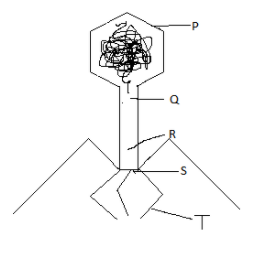
Given is an electron microscopic structure of a T2 bacteriophage. Identify the unlabelled parts and select the correct option for P,Q,R,S and T.

A. P-Head, Q-Collar, R-Sheath, S-Basal plate, T-Tail fibre
B. P-Head, Q-Collar, R-Capsid, S-Tail, T-Tail fibre
C. P-Capsid, Q-Sheath, R-Basal plate, S-Tail, T-Tail fibre
D. P-Head, Q-Collar, R-Sheath, S-Capsomere, T-Tail fibre

Answer
559.2k+ views
Hint: Bacteriophage is a type of virus that infects bacteria. The word bacteriophage means bacteria eater as bacteriophages destroy the host cells. Bacteriophages are composed of nucleic acid molecules that are surrounded by a protein structure. Bacteriophage removes the portion of bacterial DNA and transfers the infectious DNA into the genome of new host cells which is known as transduction.
Complete answer:
Bacteriophage is a virus which infects and replicates within the bacteria. The structure of bacteriophage consist of Head, Sheath, Collar, Base plate and tail fibers. It is composed of two regions: the upper part is known as Head region and the lower part is known as the Tail region. The head is hexagonal in shape and each corner or tip (icosahedral ends) contain a capsomere. Double stranded DNA is present in the head. The tail is cylindrical in shape and it has approximately 200 protein subunits of protein sheaths. The tail of bacteriophage can contract so it can easily inject its genetic material i.e. double stranded DNA into the host cell. It consists of a base plate from which tail fibers arise. The tip of tail fiber consists of hydrolysing enzymes which helps to create a hole on the surface of the host cell from where the genetic material will be pushed inside the host cell or host bacteria. The region between the head and tail is known as the collar.
Hence, the correct answer is Option (A) i.e. P-Head, Q-Collar, R-Sheath, S-Basal plate, T-Tail fiber.
Note:
Bacteriophage is known as a bacteria eater and it is a type virus. Bacteriophages infect the host cell such as E-coli or arches through their genetic material which is double stranded DNA. The tail and head are attached with the help of a collar which is also known as a neck.
Complete answer:
Bacteriophage is a virus which infects and replicates within the bacteria. The structure of bacteriophage consist of Head, Sheath, Collar, Base plate and tail fibers. It is composed of two regions: the upper part is known as Head region and the lower part is known as the Tail region. The head is hexagonal in shape and each corner or tip (icosahedral ends) contain a capsomere. Double stranded DNA is present in the head. The tail is cylindrical in shape and it has approximately 200 protein subunits of protein sheaths. The tail of bacteriophage can contract so it can easily inject its genetic material i.e. double stranded DNA into the host cell. It consists of a base plate from which tail fibers arise. The tip of tail fiber consists of hydrolysing enzymes which helps to create a hole on the surface of the host cell from where the genetic material will be pushed inside the host cell or host bacteria. The region between the head and tail is known as the collar.
Hence, the correct answer is Option (A) i.e. P-Head, Q-Collar, R-Sheath, S-Basal plate, T-Tail fiber.
Note:
Bacteriophage is known as a bacteria eater and it is a type virus. Bacteriophages infect the host cell such as E-coli or arches through their genetic material which is double stranded DNA. The tail and head are attached with the help of a collar which is also known as a neck.
Recently Updated Pages
A man running at a speed 5 ms is viewed in the side class 12 physics CBSE

The number of solutions in x in 02pi for which sqrt class 12 maths CBSE

State and explain Hardy Weinbergs Principle class 12 biology CBSE

Write any two methods of preparation of phenol Give class 12 chemistry CBSE

Which of the following statements is wrong a Amnion class 12 biology CBSE

Differentiate between action potential and resting class 12 biology CBSE

Trending doubts
What are the major means of transport Explain each class 12 social science CBSE

Which are the Top 10 Largest Countries of the World?

Draw a labelled sketch of the human eye class 12 physics CBSE

How much time does it take to bleed after eating p class 12 biology CBSE

Explain sex determination in humans with line diag class 12 biology CBSE

Explain sex determination in humans with the help of class 12 biology CBSE




